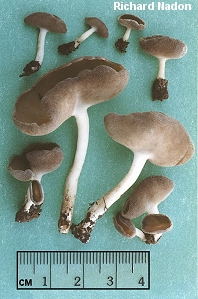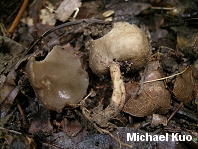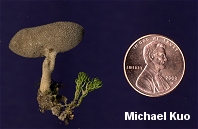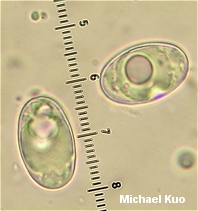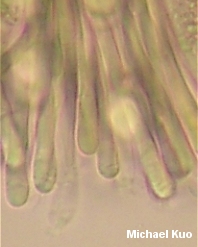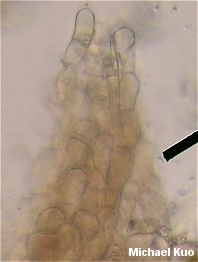| Major Groups > Cup Fungi > Helvella cupuliformis |

|
Helvella cupuliformis [ Ascomycetes > Pezizales > Helvellaceae > Helvella . . . ] by Michael Kuo This little guy is very similar to the better known Helvella macropus, but differs in its paler and often shorter stem, which is usually shorter than or about as long as the cap is wide. Spore morphology also separates the two species; the mature spores of Helvella cupuliformis are ellipsoid, rather than fusoid. Helvella cupuliformis appears to be associated with hardwoods in North America, although it often grows under conifers in Europe. In the lower Midwest it appears in early summer, but it is recorded from other locations in summer and fall, as well. Cyathipodia cupuliformis is a synonym. Helvella chinensis, also known as Helvella villosa (and as the now synonymized Helvella pallidula), is very similar, and also features ellipsoid mature spores; however, its cup is darker brown, and its stem is longer and darker. Description: Ecology: Probably mycorrhizal; growing alone or gregariously on the ground or in moss under hardwoods (especially oaks); early summer through fall; widely distributed in North America. Cap: 0.5-3.5 cm across; cup-shaped or disc-shaped--or occasionally nearly flat; upper surface medium to pale grayish brown, bald; undersurface pale grayish brown overall but usually nearly whitish near the apex of the stem, finely but densely hairy. Flesh: Insubstantial. Stem: 2-30 mm long (at maturity usually shorter than or about as long as the cap is wide); 2-8 mm thick; more or less equal; sometimes with clefts near the base; whitish to pale brownish; finely hairy or nearly bald with age. Chemical Reactions: KOH negative on surface of cup. Microscopic Features: Spores 16-21 x 11-13 µ; ellipsoid throughout development; smooth; when fresh with one large central oil droplet. Paraphyses with brownish granular contents; apices cylindric to subclavate or clavate, 4-8 µ wide. Excipular surface elements hyaline to brownish (with pigment inside the cells); often arranged in short to long fascicles; frequently septate; terminal cells subglobose. REFERENCES: Dissing & Nannfeldt, 1966. (Smith Weber, 1972;Abbott & Currah, 1997; Breitenbach & Kränzlin, 1984; McNeil, 2006.) Herb. Kuo 06170206, 06150303, 05170704, 06040801. This site contains no information about the edibility or toxicity of mushrooms. |
© MushroomExpert.Com |
|
Cite this page as: Kuo, M. (2012, October). Helvella cupuliformis. Retrieved from the MushroomExpert.Com Web site: http://www.mushroomexpert.com/helvella_cupuliformis.html |
